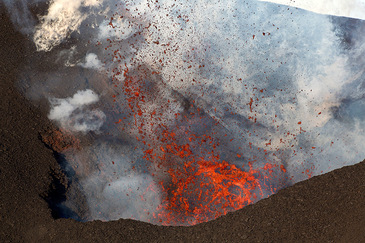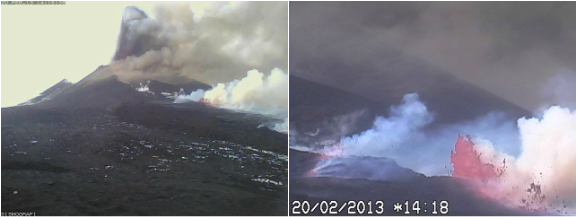 Google Earth annotated image showing crater locations. Mt Etna, has had a relatively active start to the year. The major focus of this recent activity has been at the South-East (SEC) and Bocca Nuova (BN) craters, indicated in the Google Earth image to the right. This activity has included a mixture of activity types including: strombolian , jetting (Hawaiian type) and ash emissions. This type of activity has been prominent at the volcano over the past few months, particularly in the BN crater (as I was lucky to witness in July). However, the SEC has been relatively quiet for 9 months previous to this recent reactivation. I thought that this would be a good point to briefly discuss the summit of Mt Etna. Despite a very prominent summit area from a distance, Etna has three main areas: the Central Craters (Voragine and BN), the North East crater (NEC) and SEC (and NSEC). The NEC and Voragine mostly emit gas passively. All of these contribute in a different way to the volcanism at Etna and all need to be studied in detail to gain an insight into the complexities of an active volcano. The first image below shows minor ash emission during the activity from the NSEC on the 20th February 2013. At this time of the year, the slopes of Etna are used for skiing. In certain places you can see white snow poking through a fresh covering of black ash (as a result of the basaltic magma). The ash emissions from the NSEC are clearly separated from a lower area of steam. It is even possible to notice some incandescence near to the NSEC (just below the NSEC) and against the right edge of the image and half way down. Other images below this show much more vigorous activity with the first image on the left showing a clear lava fountain. The image to the right of this shows more clearly the incandescence I mentioned earlier and shows the likely cause of all the steam (the result of lava heating snow)! This could be indicative of a fissure or a lava flow with fast flowing lava allowing it spill up over the edges spectacularly. Although the images are not 100% revealing so I can't be certain. For a discussion of the causes of strombolian and hawaiian activity please see a couple of my previous posts. Etna continues as one of the most active volcanoes on the Earth and will continue to provide a spectacular show for all of us over the coming months and far off into the future.  I am now approaching a whole five months of my PhD so far and it has been a great experience. It has dawned on me over the past few weeks, how multidisciplinary the field of volcanology is. My own work (so far) has stretched across multiple fields already such as remote sensing, statistics and mathematics, physics and chemistry, all in the pursuit of greater knowledge and understanding of volcanoes. For example understanding the chemistry of rocks allows us to understand how they may behave and act beneath the surface. Then, physics can help us to understand how bubbles move in the magma prior to emission at the surface which is then captured by remote sensing techniques. This reminds me of something I came across during a lecture on the philosophy of geography during my undergraduate degree in the form of a statement about geography: Geography - a jack of all trades or a master of none? Personally I think this is phrase is redundant. Increasingly the focus of research is inter-disciplinary (and it is easier to get research funding if you can prove it!) so I believe it is more of an advantage to have a handle-hold on many subjects/disciplines - be knowledgeable in multiple areas. However, when you delve deeper everyone has their specialty subject area; you could be an expert on climate and volcanoes, gas and volcanoes or the petrology of rocks. I guess this just emphasizes the importance of working with others to combine expertise. Going back to the original statement, 'geography - a jack of all trades or a master of none', in the academic world very few people would define themselves as a geographer, they could be an economic geographer, climatologist, hydrologist or ecologist and you could even subdivide these further! A geographer can be a specialist in his particular area whilst also have a grasp on other areas, whilst not being a master of all of these other areas, furthering scientific understanding means taking a multidisciplinary approach which couldn't be done by the master of just one trade.
 Taken by Денис Будьков, click on photo for link to site. For a few months now Plosky-Tolbachik has been erupting, producing extensive lava flows and it continues to provide us with some amazing photos. I highly recommend having a look at the following site with some truly spectacular images of the current eruption. It may seem that the people are extremely close to the eruption, however, they are about 300 metres away according to the text underneath the pictures, which explains the nonchalant stance of one of the people near to the eruption! I have pulled one of the photos off the reel and posted it to the right as it illustrates well what I have been talking about in recent posts about gas in volcanic eruptions. You can almost see the shape of the bubble which has burst at the surface by the trajectories of the lava. |
Archives
July 2023
|



 RSS Feed
RSS Feed